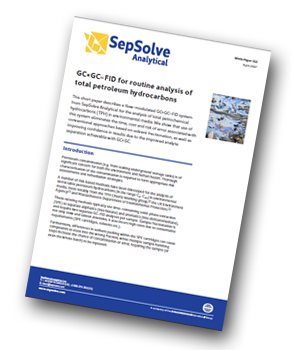SepSolve Analytical has produced an application note describing a flow-modulated GC×GC–FID system for the analysis of total petrochemical hydrocarbons (TPH) in environmental media. The application note demonstrates how use of this system eliminates the time, cost and risk of error associated with conventional approaches based on solvent fractionation, as well as improving confidence in results due to the improved analyte separation achievable with GC×GC.
 Introduction
Introduction
Petroleum contamination (e.g. from leaking underground storage tanks) is of significant concern for both the environment and human health. Thorough characterisation of the contamination is required to form appropriate risk assessments and remediation strategies.
A number of risk-based methods have been developed for the analysis of extractable petroleum hydrocarbons (in the range C8–C40) in environmental media, most notably from the TPH Criteria Working group, the UK Environment Agency and Massachusetts Department of Environmental Protection.
These existing methods typically use time-consuming solid-phase extraction (SPE) to separate aliphatics (into hexane) and aromatics (into dichloromethane), and require two separate GC–FID analyses per sample.
SepSolve’s product package for TPH analysis uses the enhanced separation capacity of comprehensive two-dimensional chromatography (GC×GC). This optimised method enables aliphatics and aromatics to be fully separated in a single run, so eliminating the need for off-line sample fractionation and multiple analyses.
Conclusions
With SepSolve’s TPH product package you can:
- Save time by eliminating the need for off-line fractionation and multiple GC runs per sample.
- Maximise sample throughput with dual injection.
- Reduce costs associated with consumables and waste disposal.
- Increase confidence in results with reliable multi-dimensional chromatography.
- Simplify the method, reducing the chance of human error and contamination.
- Eliminate the use of hazardous chemicals, decreasing the risk to your
employees and the environment.
